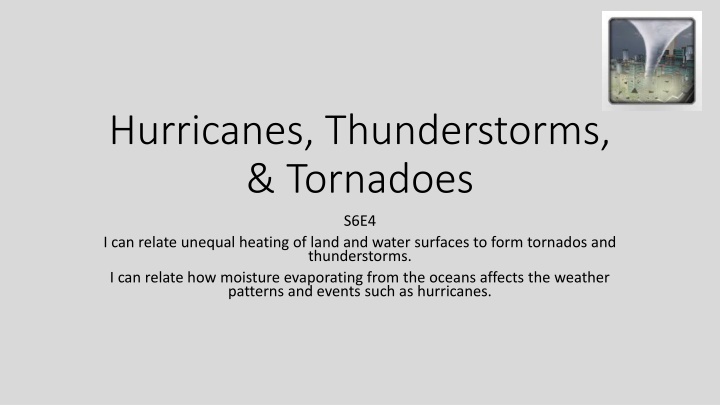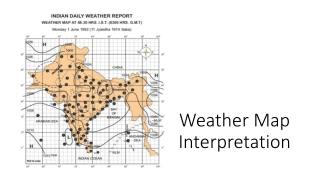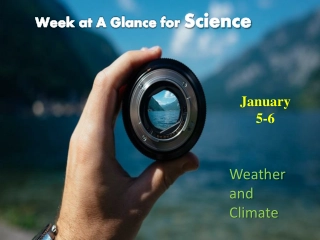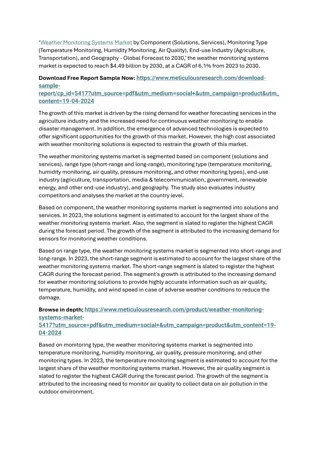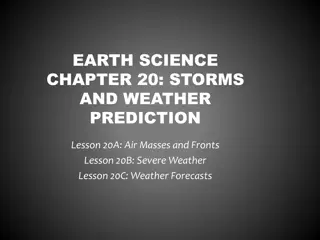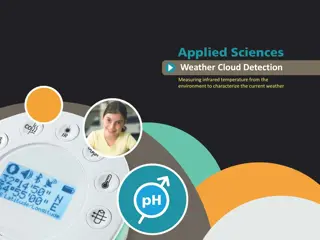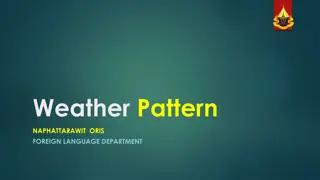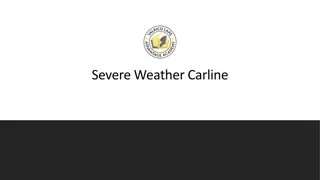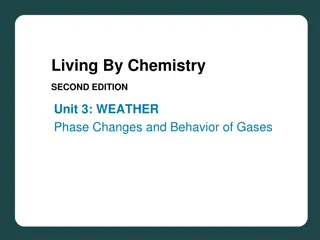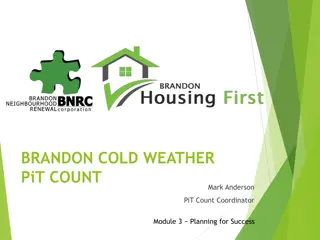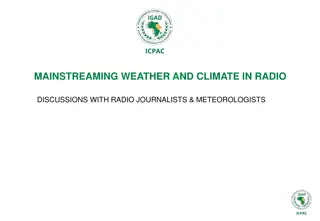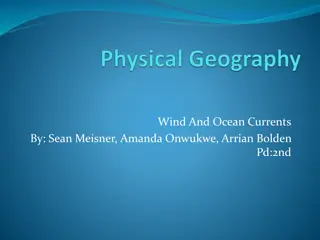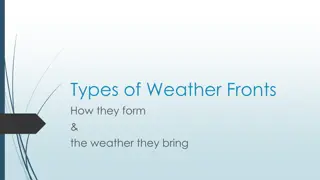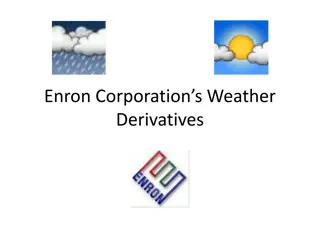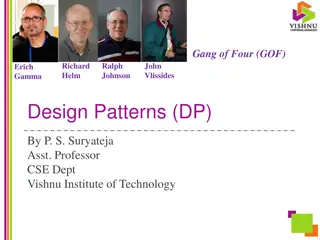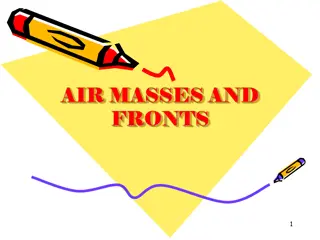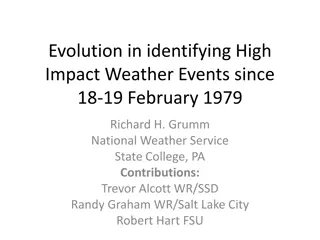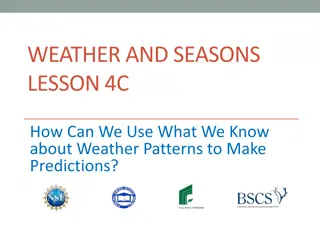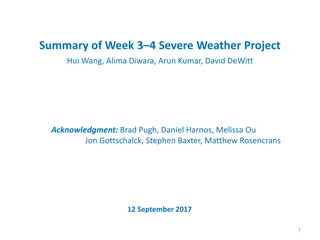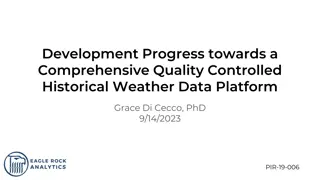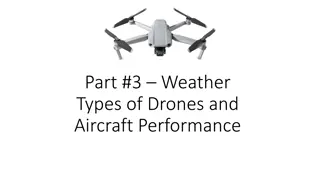Weather Patterns and Events
Unequal heating of land and water surfaces leads to the formation of tornadoes and thunderstorms, while moisture evaporating from the oceans influences weather patterns and events like hurricanes. This content delves into the formation and impact of hurricanes, thunderstorms, and tornadoes, highlighting the processes that drive these natural phenomena.
Download Presentation

Please find below an Image/Link to download the presentation.
The content on the website is provided AS IS for your information and personal use only. It may not be sold, licensed, or shared on other websites without obtaining consent from the author.If you encounter any issues during the download, it is possible that the publisher has removed the file from their server.
You are allowed to download the files provided on this website for personal or commercial use, subject to the condition that they are used lawfully. All files are the property of their respective owners.
The content on the website is provided AS IS for your information and personal use only. It may not be sold, licensed, or shared on other websites without obtaining consent from the author.
E N D
Presentation Transcript
Hurricanes, Thunderstorms, & Tornadoes S6E4 I can relate unequal heating of land and water surfaces to form tornados and thunderstorms. I can relate how moisture evaporating from the oceans affects the weather patterns and events such as hurricanes.
Hurricanes Hurricanes Large, rotating, LOWAIR PRESSURE weather system that forms over the warm ocean waters near the equator. Occur from summer through fall due to the oceans heating up. Similar storms that form over the Indian & Pacific Oceans are called cyclones. http://youtu.be/Cdh853PdVb0 4 min Hurricanes http://www.youtube.com/watch?v=xWUegShRWs0&feature=share&lis t=PLjzOc3wmoa1i-8SzFQup3po5S4mtRPiFW 4 min What is a hurricane?
http://youtu.be/Cdh853PdVb0 4 min Hurricanes http://youtu.be/zP4rgvu4xDE 3 min Hurricanes Hurricanes Hurricanes Begins as a low air pressure system tropical storm or depression Over warm, Atlantic Ocean water near Africa Winds push it eastward Gains energy from the warm, humid air just above the water Increases wind speed and rotation At wind speed of 75+ mph, it becomes a hurricane.
Hurricanes Hurricanes when they reach land when they reach land Bring heavy rains and strong winds Winds blow seawater toward land The rise in water as it moves inland is called a storm surge. Storm surges causes the most damage - flooding in the coastal areas
Hurricanes Hurricanes A hurricane weakens as it moves inland or makes landfall. WHY? Without the heat energy from the ocean, it loses energy quickly. A huge weather storm that can last for days and even weeks.
http://youtu.be/exlVSEPEXKc 1 min thunderstorm formation THUNDERSTORMS THUNDERSTORMS http://youtu.be/NxWbR60tFlg 1 min The Thunderstorm Recipe LOW AIR PRESSURE weather system Heavy rainstorm that includes lightning as well as thunder Form when there is unstable air and moisture Common on hot, humid days, especially on summer afternoons Small compared to hurricanes, but can be deadly. Short-lived http://youtu.be/7nZlGg59MRw 3 min Thunderstorm song Mr. Parr
http://youtu.be/RDDfkKEa2ls 2 min upward lightning THUNDERSTORMS THUNDERSTORMS http://youtu.be/RLWIBrweSU8 3 min lightning http://youtu.be/jM8h60S1GsM 2 min explains lightning Winds inside the thunderstorm cause electrical charges to build up. When charges move from cloud to cloud, or to ground, this is called lightning. Lightning heats the air, causing the air to expand. Which causes a shock wave or thunder.
THUNDERSTORMS THUNDERSTORMS The SUN heats the Earth s surface. The surface heats the air above it. This produces convection currents warm air rises and cool air sinks in to replace it. Tall clouds called thunderheads are formed.
http://youtu.be/ur0k7UDrrvg 4 min cloud types with music CLOUDS CLOUDS A cloud is a collection of millions of tiny water droplets. Remember the WATER CYCLE HEAT (Sun) EVAPORATION water vapor cool air CONDENSATION water droplets cloud formation PRECIPITATION (rain, snow, sleet or hail)
Precipitation Precipitation Precipitation is any form of water falling to Earth rain, sleet, snow or hail. Rain is the most common form. Sleet starts out as rain and then freezes. Snow forms from a gas (water vapor) into a solid. Hail is very damaging because it is balls of ice.
http://youtu.be/MRykm-xjPsk 1 min The Anatomy of a tornado http://youtu.be/006guBgSf14 2 min Actual footage of a forming tornado TORNADOES TORNADOES A tornado is a high- speed, spinning (rotating) column of air It is a LOW AIR PRESSURE weather system. Tornadoes produces Earth s most powerful winds. Small compared to hurricanes but still deadly Short-lived
TORNADOES TORNADOES Begins as a funnel-shaped cloud that is rotating. When the funnel cloud touches the Earth s surface, it picks up dust and debris. The flying debris causes the most damage to property and buildings, and to the people inside the buildings.
